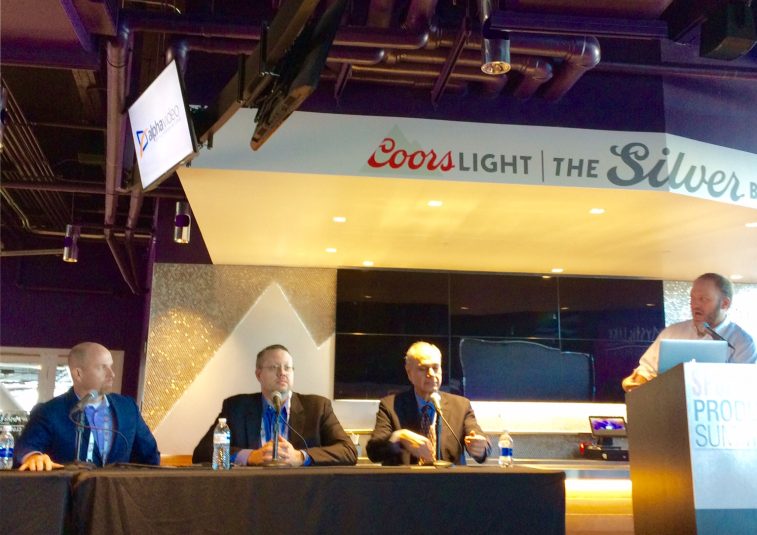Sports Venue Production Summit: In-Venue Production Takes a Cue From Broadcast
Top-level cameras/lenses, 4K, HDR are part of the discussion for video capture
Story Highlights
The in-venue production teams at sports venues continue to close the technical gap between themselves and broadcasters as they look to create high-quality, no-compromise content for their fans and help the home team get the occasional advantage via video.

Moderated by SVG’s Jason Dachman (at podium), the panel on choosing the right capture technology comprised (from left) Sony’s Mike DesRoches, Van Wagner’s Steve Serfling, and Fujinon’s Alan Tanielian.
A panel discussion at the 2017 Venue Technology Summit at U.S. Bank Stadium in Minneapolis this week laid out the evidence, describing how the home of the Minnesota Vikings has embraced broadcast-quality equipment across the board.
“This place did it right, and they did their homework,” said Mike DesRoches, senior sales support engineer, Sony Electronics. “They have great content for the boards and use Sony cameras that can resolve the proper purple, which is the color that every camera hates to do. But it’s like the Denver Broncos and their ability to shoot orange in a way that really pops. It’s exciting to be here and see cameras that are the same as those used in a high-end broadcast.”
Steve Serfling, director of technology services, Van Wagner Sports & Entertainment, agreed that the team at U.S. Bank Stadium did it right, looking at multiple technologies and now making use of 1080p and 4K.
“[Vikings VP, Content and Production,] Bryan Harper had a vision and knew what he wanted to achieve,” Serfling said. “We collaborated and looked at the different camera technologies to acquire content for the videoboards, TV shows, and in-venue apps. There was a lot of research for the best way to capture and then archive video for use down the road.”
Alan Tanielian, regional sales manager, Fujinon Optical Devices, noted that the use of Fujinon lenses at U.S. bank Stadium took a lot of study to ensure that the right lenses were used for the right angle of view.
“What kind of shot do you want?,” he said. “You can want a headshot, but what does that mean? You have to figure out if you want a wide shot or a tight shot and how big you want the head to be.”
DesRoches observed that the flexibility of cameras is one key, with such capabilities as high frame rate helping the replay operator become a storyteller. That flexibility also means that different types of events can be held in a facility like U.S. Bank Stadium and different needs can be easily met.
“The idea is to use the control room as a revenue stream,” he added. Someone holding an event at the stadium “could rent out the control room and won’t need as many production trucks.”
The case can also be made that an investment in additional cameras and better lenses could make the difference between making or not making the playoffs. A high-quality combo can provide a view of a play that could allow it to be overturned in the home team’s favor. That could provide an extra win or, from a season, a margin that is sometimes enough to make it into the playoffs.
“A lot of teams are taking 4K and, in the replay, zoom in to take a closer look and then sell it to the coaching staff,” said DesRoches. “It is not an immediate ROI, but people can get behind it.”
Tanielian said the philosophy for a new installation is simple: do you want something you can grow into or grow out of?
“It’s hard to see the future, so you need to make the best bet possible,” he explained. “As good as the integrators are, a venue team should always talk to equipment manufacturers to get more specifics.”
The 4K and HDR future is also on everyone’s mind. The big scoreboards can make use of the improved resolution, and 4K material today is more valuable tomorrow.
Serfling pointed out that 4K is getting the most attention because it is what is being talked about at consumer-electronics stores. But he wonders whether the technology is the right fit for venues because the difference is often hard to see on the vast majority of displays.
“The big impact is HDR, as you can see more vibrant colors,” he said. “That is what people notice.”
A combo of 1080p and HDR is also being talked about more often. Serfling observed, “Fans will notice bright, vibrant colors faster than they will notice more pixels.”
DesRoches agreed that 4K is the current story. He pointed out that Netflix and Amazon services have embraced 4K and are looking to HDR. Although 4K HDR may not be of great interest for broadcast because standards like ATSC 3.0 are not yet fully developed, an HD HDR production can be done out of the same facility used for HD today.
The panelists look forward to NAB 2017 for a forecast of what acquisition trends will be top of mind.
“There are many things being discussed right now,” said Serfling. “I think the two biggest things will be, everything will be done on an IP infrastructure and that will allow for more 4K and even 8K, especially with the Olympics coming up in 2020.”
DesRoches considers the viewing experience of 4K plus HDR astounding but thinks HD HDR will be the first technology to create a tug of war for casual fans, who will want to stay home because the experience will be so much better than what they are used to.
